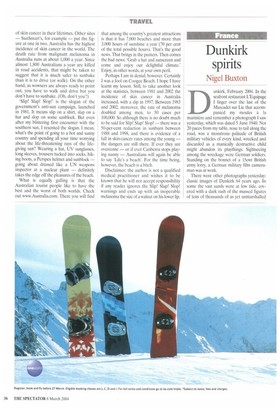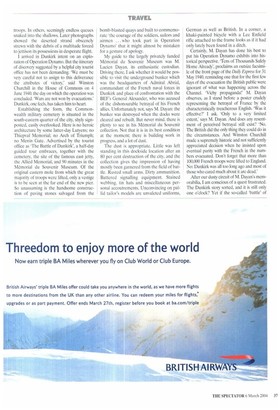Dunkirk spirits
Nigel Buxton
unkirk, February 2004. In the seafront restaurant L'Equipage I linger over the last of the Muscadet sur Lie that accompanied my moules a la mariniere and remember a photograph I saw yesterday, which was dated 5 June 1940. Not 20 paces from my table, nose to tail along the road, was a monstrous palisade of British military vehicles of every kind, wrecked and discarded as a manically destructive child might abandon its playthings. Sightseeing among the wreckage were German soldiers. Standing on the bonnet of a 15cwt British army lorry, a German military film cameraman was at work.
There were other photographs yesterday: classic images of Dunkirk 64 years ago. In some the vast sands were at low tide, covered with a dark rash of the massed figures of tens of thousands of as yet unmarshalled troops. In others, seemingly endless queues snaked into the shallows. Later photographs showed the deserted strand obscenely strewn with the debris of a multitude forced to jettison its possessions in desperate flight.
I arrived in Dunkirk intent on an exploration of Operation Dynamo. But the itinerary of discovery suggested by a helpful city tourist office has not been demanding. 'We must be very careful not to assign to this deliverance the attributes of victory.' said Winston Churchill in the House of Commons on 4 June 1940, the day on which the operation was concluded. 'Wars are not won by evacuations.' Dunkirk, one feels, has taken him to heart.
Establishing the form, the Commonwealth military cemetery is situated in the south-eastern quarter of the city, shyly signposted, easily overlooked. Here is no heroic architecture by some latter-day Lutyens; no Thiepval Memorial; no Arch of Triumph; no Menin Gate. Advertised by the tourist office as 'The Battle of Dunkirk', a half-day guided tour embraces, together with the cemetery. the site of the famous east jetty, the Allied Memorial, and 90 minutes in the Memorial du Souvenir Museum. Of the original eastern mole from which the great majority of troops were lifted, only a vestige is to be seen at the far end of the new pier. So unassuming is the handsome construction of paving stones salvaged from the bomb-blasted quays and built to commemorate 'the courage of the soldiers, sailors and airmen . . . who took part in Operation Dynamo' that it might almost be mistaken for a gesture of apology.
My guide to the largely privately funded Memorial du Souvenir Museum was M. Lucien Dayan, its enthusiastic custodian. Driving there, I ask whether it would be possible to visit the underground bunker which was the headquarters of Admiral Abrial, commandant of the French naval forces in Dunkirk and place of confrontation with the BEF's General Alexander, who was accused of the dishonourable betrayal of his French allies. Unfortunately not, says M. Dayan: the bunker was destroyed when the docks were cleared and rebuilt. But never mind, there is plenty to see in his Memorial du Souvenir collection. Not that it is in its best condition at the moment; there is building work in progress, and a lot of dust.
The dust is appropriate. Little was left standing in this dockside location after an 80 per cent destruction of the city, and the collection gives the impression of having mostly been garnered from the field of battle. Rusted small arms. Dirty ammunition. Battered signalling equipment. Stained webbing, tin hats and miscellaneous personal accoutrements. Unconvincing on pallid tailor's models are unvaleted uniforms, German as well as British. In a corner, a khaki-painted bicycle with a Lee Enfield rifle attached to the frame looks as if it had only lately been found in a ditch.
Certainty, M. Dayan has done his best to put his Operation Dynamo exhibits into historical perspective. 'Tens of Thousands Safely Home Already', proclaims an outsize facsimile of the front page of the Daily Express for 31 May 1940, reminding one that for the first few days of the evacuation the British public were ignorant of what was happening across the Channel. 'Vichy propaganda!' M. Dayan observes, as I stand before a poster crudely representing the betrayal of France by the characteristically treacherous English. 'Was it effective?' I ask. 'Only to a very limited extent,' says M. Dayan. And does any resentment of perceived betrayal still exist? 'No. The British did the only thing they could do in the circumstances. And Winston Churchill made a supremely historic and not sufficiently appreciated decision when he insisted upon eventual parity with the French in the numbers evacuated. Don't forget that more than 100,000 French troops were lifted to England. No: Dunkirk was all too long ago and most of those who cared much about it are dead.'
After our dusty circuit of M. Dayan's memorabilia, I am conscious of a quest frustrated. The Dunkirk story sorted, and it is still only one o'clock? Yet if the so-called 'battle' of the beaches and the dunes is so sparsely illustrated, what of the fortnight of increasingly desperate actions on a steadily and perilously shrinking perimeter? Surely on the banks of some heroically defended canal, in some strategically significant wood or some fiercely disputed village square, there will be individual battalion or regimental memorials of the kind to be seen all over the battlefields of the Somme and Passchendaele? The tourist office cannot enlighten me. I can find nothing on my maps.
The next day I walk eastwards along the beach, thinking about the Miracle of Dunkirk. 'Look carefully, and at low tide you will see some of the wrecks,' M. Dayan said. 'They're all over the place.' A few hundred yards from where the smallest of waves are creeping gently towards me, I see the blackened ribs of what must have been a sizeable boat sticking up from the shallows. Further out, what I had first taken for a reef now appears as the vestiges of a larger vessel.
If indeed Dunkirk was a miracle, it was one to which both the Admiralty and the Air Ministry could have proposed useful modifications. The evacuation cost the Royal Navy dear: six destroyers sunk, more than 20 severely damaged, and more than 1,500 men killed. In the nine days' wonder, the RAF lost more than 150 fighter aircraft and more
than 100 of their pilots. When the sky was unclouded it aided German bombers and British fighters more or less evenhandedly. More than 1,000 of the escaping troops were subsequently drowned, shot, burned or bombed offshore. Though the part that the 'little ships' played in the last two days of Operation Dynamo was noble, divine intervention might have had them there a trifle earlier. It was providential that a seemingly unsuccessful but salutary British counterattack confirmed Hitler in his decision to halt his panzers for 48 hours, but it was a devilishly close-run contest in the holding of the perimeter by the British and French, and a cruel necessity that compelled Admiral Ramsay finally to call off any further rescue attempts, when many thousands of mainly French troops were still waiting on the quays.
With the dark coming on, I walk back to my car for the three-hour drive to Dieppe and the ferry for Newhaven. To the west, smoke and steam billowing high from the steel works and refineries beyond the port assume remarkably similar shapes to those that rose from burning oil in those other classic pictures of Dunkirk in 1940. But the sands and the dunes are as they must have been for centuries before the dynamo was ever invented.




















































































 Previous page
Previous page